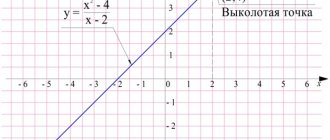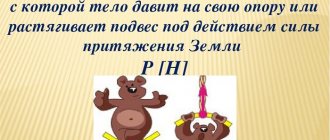Internal energy
In physics there are several types of phenomena such as mechanical, thermal, light, electromagnetic and other phenomena. Any such phenomenon is accompanied by energy expenditure. It is known that there are two types of mechanical energy: kinetic and potential.
Kinetic energy is the energy of a moving body.
That is, any moving object has kinetic energy.
It could be a moving car, a walking person, a running dog, and so on. Kinetic energy depends on the mass of the body and the speed of its movement
. Kinetic energy is calculated using the following formula:
Potential energy is a characteristic of the interaction of several bodies in accordance with their location relative to each other.
For example, any body raised above the ground has potential energy. Potential energy depends on the mass of the body and the height to which this body is raised and is calculated by the formula:
In addition, the body can possess both types of energy at the same time. Let's say an airplane moves at a certain speed (and therefore has kinetic energy) and flies at a certain altitude (and therefore has potential energy).
In this case, the total energy of the body will be the sum of the potential and kinetic energies: E = Ek + En.
Kinetic and potential energy can be converted into each other. The most obvious example is a free fall, in which the body loses altitude but gains speed. Let's say the ball is held at the initial height h0. Then it has potential energy mgh0 and zero speed. In this case, the kinetic energy will be zero.
Let's say the ball is released. As a result of free fall, the body moved to the point of contact with the ground, and accordingly, to zero height. Now the potential energy is zero. However, as the ball fell, the speed of the ball increased from zero to v. Consequently, its kinetic energy increased to
Thus, the ball lost all its potential energy, but gained kinetic energy, although at first it did not have kinetic energy, but had potential energy.
Note, however, that after contact with the ground and several bounces, the ball remained motionless on the ground. This means that he also lost kinetic energy. In no case should one conclude from this that the energy of the ball simply disappeared. If we look closely, we will see that at the moment of impact the ball was slightly flattened, and then again acquired its original shape due to its elasticity. Then he jumped, but to a height less than the original one. And so on until it stopped completely. Each time it was hit, the ball deformed and returned to its original shape. Part of the mechanical energy was spent on this. In addition, if we measure the temperature of the ball, we will see that it warms up a little (as does the area of the surface it hits). And, as we remember from the previous lesson, temperature is a measure of the kinetic energy of molecules
.
Consequently, part of the mechanical energy turned into the internal energy of the ball
.
The internal energy of a body consists of the mechanical energy of molecules: kinetic and potential.
Just as in a system of bodies, the energy of the system consists of the energies of each body; in a body, the internal energy consists of the energy of molecules:
The internal energy of a body depends on temperature
(since temperature describes the kinetic energy of molecules)
and the state of aggregation of a substance
(since the location of molecules relative to each other depends on it). This brings us to the topic of the next lesson: ways to change internal energy. Note, however, that the speed of the body itself does not affect the internal energy in any way, just as its position relative to other bodies does not affect the distance between the molecules.
Lesson topic "Internal energy" lesson plan in physics (8th grade)
Physics lesson in 8th grade on the topic: “Internal energy. Ways to change internal energy"
Lesson objectives:
- Formation of the concept of “internal energy of the body” based on MCT of the structure of matter.
- Familiarization with ways to change the internal energy of the body.
- Formation of the concept of “heat transfer” and the ability to apply knowledge of MCT of the structure of matter in explaining thermal phenomena.
- Developing interest in physics through demonstration of interesting examples of the manifestation of thermal phenomena in nature and technology.
- Justification of the need to study thermal phenomena to apply this knowledge in everyday life.
- Development of information and communication competencies of students.
Lesson type. Combined lesson.
Type of lesson. Lesson - presentation
Lesson format. Interactive conversation, demonstration experiment, story, independent work
Forms of student work. Teamwork, individual work, group work.
Equipment: electronic presentation “Internal energy. Methods of changing internal energy", computer, projector.
During the classes
Organizing time. Good afternoon Today in the lesson we will get acquainted with another type of energy, find out what it depends on and how it can be changed.
Updating knowledge.
- Repetition of basic concepts: energy, kinetic and potential energy, mechanical work.
Learning new material.
Teacher. In addition to the concepts mentioned, it should be remembered that two types of mechanical energy can transform (transition) into each other, for example, when a body falls. Consider a freely falling ball. Obviously, when falling, its height above the surface decreases and its speed increases, this means that its potential energy decreases and its kinetic energy increases. It should be understood that these two processes do not occur separately, they are interconnected, and they say that potential energy is converted into kinetic energy.
To understand what the internal energy of a body is, it is necessary to answer the following question: what are all bodies made of?
Students. Bodies consist of particles that continuously move chaotically and interact with each other.
Teacher. And if they move and interact, then they have kinetic and potential energy, which constitute internal energy.
Students. It turns out that all bodies have the same internal energy, which means the temperature should be the same. But this is not so.
Teacher. Of course not. Bodies have different internal energies, and we will try to find out what the internal energy of a body depends on and what does not depend on.
Definition.
The kinetic energy of the movement of particles and the potential energy of their interaction constitute the internal energy of the body.
Internal energy is designated and measured, like all other types of energy, in J (joules).
Consequently, we have a formula for the internal energy of the body: . Where by is meant the kinetic energy of the particles of the body, and by is their potential energy.
Let's remember the previous lesson, in which we talked about the fact that the movement of particles of a body is characterized by its temperature, on the other hand, the internal energy of the body is related to the nature (activity) of the movement of particles. Therefore, internal energy and temperature are interrelated concepts. When the body temperature increases, its internal energy also increases, and when it decreases, it decreases.
We found out that the internal energy of the body can change. Let's consider ways to change the internal energy of the body.
You are already familiar with the concept of mechanical work of a body; it is associated with the movement of a body when a certain force is applied to it. If mechanical work is performed, then the energy of the body changes, and the same can be said specifically about the internal energy of the body. It is convenient to depict this in a diagram:
Teacher. The method of increasing the internal energy of a body through friction has been known to people since ancient times. This is how people made fire. When working in workshops, for example, turning parts with a file, what can you observe? (The parts became hot.) When a person is cold, he begins to shiver involuntarily. Why do you think? (When trembling, muscle contractions occur. Due to muscle work, the internal energy of the body increases and becomes warmer). What conclusion can be drawn from what has been said?
Students. The internal energy of a body changes when work is done. If the body itself does work, its internal energy decreases, and if work is done on it, then its internal energy increases.
Teacher. In technology, industry, and everyday practice, we constantly encounter changes in the internal energy of a body when performing work: heating of bodies during forging, during impact; performing work with compressed air or steam.
Let's relax a little, and at the same time learn some interesting facts from the history of thermal phenomena (two students give short messages prepared in advance).
Message 1. How miracles were performed.
The ancient Greek mechanic Heron of Alexandria, the inventor of the fountain that bears his name, left us a description of two ingenious ways in which the Egyptian priests deceived the people into believing in miracles. In Figure 1 you see a hollow metal altar, and underneath it a mechanism hidden in the dungeon that moves the doors of the temple. The altar stood outside it. When a fire is lit, the air inside the altar, due to heating, puts more pressure on the water in the vessel hidden under the floor; From the vessel, water is forced out through a tube and poured into a bucket, which, when lowered, activates a mechanism that rotates the doors (Fig. 2). Amazed spectators, unaware of the installation hidden under the hollow, see a “miracle” in front of them: as soon as the fire blazes on the altar, the doors of the temple, “listening to the prayers of the priest,” dissolve as if by themselves...
Exposing the “miracle” of the Egyptian priests: the doors of the temple are opened by the action of sacrificial fire.
Message 2. How miracles were performed.
Another imaginary miracle performed by the priests is shown in Fig. 3. When a flame blazes on the altar, the air, expanding, removes the oil from the lower reservoir into the tubes hidden inside the figures of the priests, and then the oil miraculously itself is added to the fire... But as soon as the priest in charge of this altar quietly removed the plug from the lid of the reservoir - and the outpouring of oil stopped (because excess air escaped freely through the hole); The priests resorted to this trick when the offerings of the worshipers were too meager.
Teacher. How familiar we all are with morning tea! It’s so nice to brew tea, pour sugar into a cup and drink a little, with a small spoon. Only one thing is bad - the spoon is too hot! What happened to the spoon? Why did her temperature rise? Why did her internal energy increase? Have we done work on it?
Students. No, they didn't.
Teacher. Let's find out why the change in internal energy occurred.
Initially, the temperature of the water is higher than the temperature of the spoon, and therefore the speed of the water molecules is greater. This means that water molecules have more kinetic energy than the particles of the metal from which the spoon is made. When they collide with metal particles, water molecules transfer part of their energy to them, and the kinetic energy of the metal particles increases, and the kinetic energy of water molecules decreases. This method of changing the internal energy of bodies is called heat transfer. In our daily life we often encounter this phenomenon. For example, in water, when lying on the ground or in snow, the body cools, which can lead to colds or frostbite. In severe frost, ducks willingly climb into the water. Why do you think? (In severe frost, the water temperature is much higher than the ambient air temperature, so the bird will cool less in water than in air). Heat transfer occurs in several ways, but we will talk about this in the next lesson.
Thus, there are two possible ways to change the internal energy. Which?
Students. Work performance and heat transfer.
Consolidation of the studied material. Now let's see how well you have learned the new material from today's lesson. I will ask questions, and you will try to answer them.
Question 1. Cold water is poured into one glass, and the same amount of boiling water is poured into the other. In which glass does the water have more internal energy? (In the second, because its temperature is higher).
Question 2. Two copper bars have the same temperature, but the mass of one is 1 kg, and the other is 0.5 kg. Which of the two given bars has greater internal energy? (The first one, because its mass is greater).
Question 3: A hammer gets hot when it is struck, for example, on an anvil, and when it is lying in the sun on a hot summer day. Name ways to change the internal energy of the hammer in both cases. (In the first case, work is performed, and in the second, heat transfer).
Question 4. Water is poured into a metal mug. Which of the following causes a change in the internal energy of water? (13)
- Heating water on a hot stove.
- Performing work on water, bringing it into forward motion together with the mug.
- Perform work on water by mixing it with a mixer.
Teacher. And now I suggest you work on your own. (Students are divided into 6 groups, and further work will be carried out in groups). In front of you is a sheet of paper with three tasks.
Task 1. What is the reason for the change in the internal energy of bodies in the phenomena below:
- heating water with a boiler;
- cooling food placed in the refrigerator;
- ignition of a match when struck against a box;
- strong heating and combustion of artificial earth satellites when they enter the lower dense layers of the atmosphere;
- if you quickly bend the wire in the same place, first in one direction, then in the other, then this place becomes very hot;
- cooking food;
- If you quickly slide down a pole or rope, you can burn your hands;
- heating the pool water on a hot summer day;
- When driving a nail, its head heats up;
- A match flares up when it is placed into a candle flame.
| Getting the job done | Heat transfer |
| 3, 4, 5, 7, 9 | 1, 2, 6, 8, 10 |
Task 2. Give examples of changes in the internal energy of a body in the process of doing work during: friction, impact, compression.
| By friction | On impact | When compressed |
For two groups – with friction; the other two groups - during impact and two more groups - during compression.
Reflection.
- What new or interesting things did you learn in class today?
- How did you learn the material you covered?
- What were the difficulties? Did you manage to overcome them?
- Will the knowledge you gained in today's lesson be useful to you?
Summing up the lesson. Today we got acquainted with the basic concepts of the section “Thermal Phenomena”: internal energy and heat transfer and became familiar with the ways of changing the internal energy of bodies. The knowledge gained will help you explain and predict the course of thermal processes that you will encounter in your life.
Homework. § 2, 3. Experimental tasks:
- Use a home thermometer to measure the temperature of the water poured into a jar or bottle. Close the vessel tightly and shake it vigorously for 10–15 minutes, then measure the temperature again. To prevent heat transfer from your hands, wear mittens or wrap the vessel in a towel. What method of changing internal energy did you use? Explain.
- Take a rubber band tied with a ring, apply the band to your forehead and note its temperature. Holding the rubber with your fingers, vigorously stretch it several times and, when stretched, press it again to your forehead. Draw a conclusion about the temperature and the reasons that caused the change.







